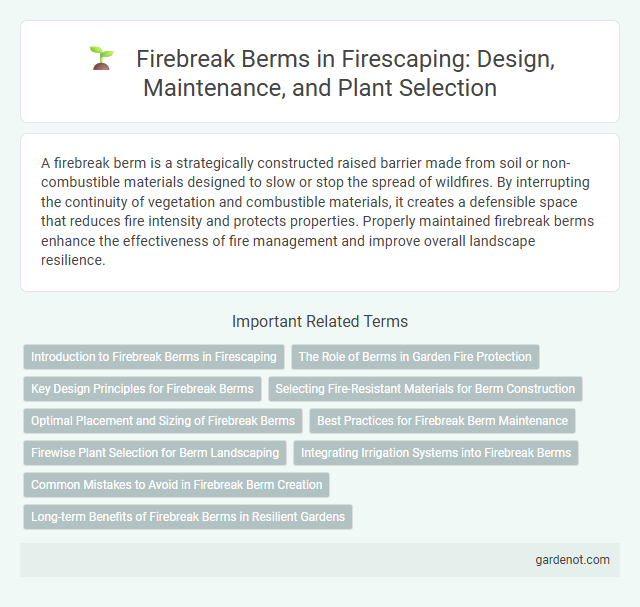A firebreak berm is a strategically constructed raised barrier made from soil or non-combustible materials designed to slow or stop the spread of wildfires. By interrupting the continuity of vegetation and combustible materials, it creates a defensible space that reduces fire intensity and protects properties. Properly maintained firebreak berms enhance the effectiveness of fire management and improve overall landscape resilience.
Introduction to Firebreak Berms in Firescaping
Firebreak berms are elevated mounds of soil strategically designed to interrupt fuel continuity and reduce wildfire spread in firescaping. By creating physical barriers composed of mineral soil, these earthworks limit fire intensity and offer safe zones for firefighting and vegetation management. Proper placement and maintenance of firebreak berms are essential components in effective landscape fire mitigation strategies.
The Role of Berms in Garden Fire Protection
Firebreak berms serve as strategic raised barriers constructed from soil or mulch, effectively interrupting the spread of wildfires by reducing available fuel and altering fire behavior. Positioned around garden perimeters or sensitive plantings, these berms create defensible spaces that limit ember intrusion and slow flame advancement. Integrating firebreak berms with drought-resistant vegetation enhances garden fire protection by combining physical barriers and fire-resistant plant materials.
Key Design Principles for Firebreak Berms
Firebreak berms are designed to create a physical barrier that slows or stops the spread of wildfire by removing flammable vegetation and materials. Key design principles include ensuring berm height and width are sufficient to interrupt fire paths, selecting fire-resistant materials for construction, and incorporating appropriate drainage to prevent erosion and maintain structural integrity. Positioning berms strategically in relation to prevailing wind and topography enhances their effectiveness in protecting vulnerable areas during fires.
Selecting Fire-Resistant Materials for Berm Construction
Selecting fire-resistant materials for firebreak berm construction is crucial to ensure effective wildfire defense and minimize fuel availability. Materials such as gravel, crushed stone, and non-combustible sand offer durability and fire resistance, reducing the risk of ember ignition along the berm. Incorporating native, fire-retardant vegetation around the berm further enhances firebreak performance by creating a natural buffer that slows wildfire spread.
Optimal Placement and Sizing of Firebreak Berms
Optimal placement and sizing of firebreak berms depend on topography, vegetation density, and prevailing wind patterns to effectively slow or stop wildfire spread. Firebreak berms should be constructed with sufficient width and height, typically at least 10 feet wide and 3 feet high, to create a physical barrier that reduces fuel continuity and shields vulnerable structures. Strategic positioning along slopes and around high-risk areas ensures maximum protection by intercepting embers and reducing fire intensity.
Best Practices for Firebreak Berm Maintenance
Regular inspection and clearing of vegetation on firebreak berms reduce fuel buildup and enhance their effectiveness in wildfire defense. Maintaining proper soil compaction and grading ensures water drainage prevents erosion, preserving berm integrity. Applying mulch or gravel layers can also minimize weed growth and improve berm durability over time.
Firewise Plant Selection for Berm Landscaping
Firebreak berms utilize strategic Firewise plant selection to reduce wildfire risk by prioritizing low-flammability species such as succulents, deciduous shrubs, and fire-resistant ground covers. Properly spaced plants with high moisture content support the berm's function in interrupting fire spread while enhancing landscape aesthetics. Integrating native, drought-tolerant vegetation on firebreak berms ensures both fire safety compliance and ecological sustainability.
Integrating Irrigation Systems into Firebreak Berms
Integrating irrigation systems into firebreak berms enhances their effectiveness by maintaining optimal soil moisture levels, reducing the risk of wildfire ignition and spread. Properly designed drip or sprinkler systems support vegetation health on berms, ensuring that fire-resistant plants remain hydrated even during dry seasons. This combination of firebreak structure and irrigation technology creates a sustainable barrier that actively mitigates fire hazards in high-risk landscapes.
Common Mistakes to Avoid in Firebreak Berm Creation
Firebreak berms often fail due to improper placement too close to combustible vegetation, which undermines their effectiveness in halting wildfire spread. Inadequate height and width of berms can allow embers to jump the barrier, rendering the firebreak useless during high wind conditions. Failing to maintain the berm by removing accumulated debris and ensuring compacted soil leads to weakened fire resistance and increased vulnerability.
Long-term Benefits of Firebreak Berms in Resilient Gardens
Firebreak berms create strategically elevated soil mounds that act as physical barriers, reducing the spread of wildfires by interrupting fuel continuity. These berms support resilient gardens by enhancing soil drainage, promoting healthier plant growth, and improving moisture retention, which collectively contribute to long-term landscape stability. Integrating firebreak berms helps safeguard property and ecosystems, making gardens more resistant to fire damage over extended periods.
Firebreak berm Infographic

 gardenot.com
gardenot.com